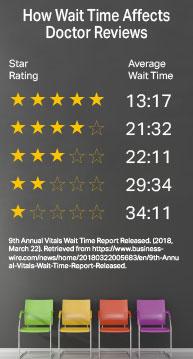
Excerpt from How to Improve the Patient Experience in the Waiting Room as published in the Q4·2019 edition of Population Health Magazine.
The folks at Vitals, the physician rating company, conduct an annual study on wait times. The correlation between the amount of time a patient waits to see a doctor, or the patient experience (PX) and that doctor’s average rating is easy to spot. In their most recent study, released in March 2018, doctors with 5-star ratings posted a wait time average of 13:17. Doctors receiving only a one-star rating had wait times of more than 34 minutes!

Let’s be honest: if you had to wait 34 minutes to see a doctor are you going to give them more than one star? (Are you also shocked that we’ll wait more than thirteen minutes in a cough-infested reception area and still give the doctor five stars?)
Ratings are critical to every practice. Persons looking for a new physician are either asking a friend who they like, or they search online. Any doctor with less than four stars is losing multiple opportunities every day to acquire a new patient or family.
Upon careful reflection, all of the planets, moons, and stars must be aligned for every patient to wait next to nothing to see their doctor. Perhaps there’s a different way to look at the patient experience challenge because the planets, moons, and stars only align every one thousand years or so.
Treating the Symptoms to Improve Px
Imagine receiving a text message from your doctor that said, “Andy, this is Dr. Brown. I’m running 30 minutes behind today. Can we move your appointment to 2:30 or would you like to reschedule?”
Wow!
With that one considerate message my respect for my doctor just skyrocketed. Finally, a medical practice that respects my time as much as they value their own. Upon receiving the message I can reply to my doctor my preferences. If I wish to move my appointment to 2:30, the receptionist edits my appointment information. If I wish to reschedule, I can work out the details via text message with the receptionist.
The technology required to improve patient experience using the aforementioned technology already exists. RelevantMD’s patient messaging technology, for example, now includes a feature that makes it possible for a front desk to message every patient with an appointment for the day via text message. The patient is notified of the backlog and given the option to come in later or reschedule. The technology automates the process to the point of your being able to complete the task in less than 30 seconds.
I know what you’re thinking. Sometimes the doctor is able to get back on schedule. So you wouldn’t want to change times for all appointments for the day; the daily production for the day would be needlessly decreased. The production wouldn’t be lost, only postponed; however, being able to bill for production now instead of later is a best practice.
In the case of RelevantMD’s technology, there’s a nifty solution to this patient experience dilemma. When you send a “we’re behind schedule” text message, the system sends the message an hour or 45 minutes prior to the scheduled appointment time (you decide on the interval). The messages are not sent all at once. As a result, if the doctor does get back on schedule, the front desk can cancel any unsent messages.
One thing needs to be clear: RelevantMD’s wait time management features don’t cure the disease. Rather, they only treat the symptoms, for now. But treating the symptoms, by communicating with your patients when it matters most to them, is strapping a rocket engine to PX.
A Change of One Degree to Start
One of the most influential contributors to New Age philosophy, Deepak Chopra, quipped, “All great changes are preceded by chaos.” Surely the waiting room Px is in a state of disarray and surely the path forward is becoming more and more clear: engage the patient in meaningful conversation in order to avoid frustrating situations.
One small change in your practice can lead to giant improvements in patient experience over time. Messaging your patients when the schedule is backed up, for example, is really a small change. But the net effect on Px can be huge.